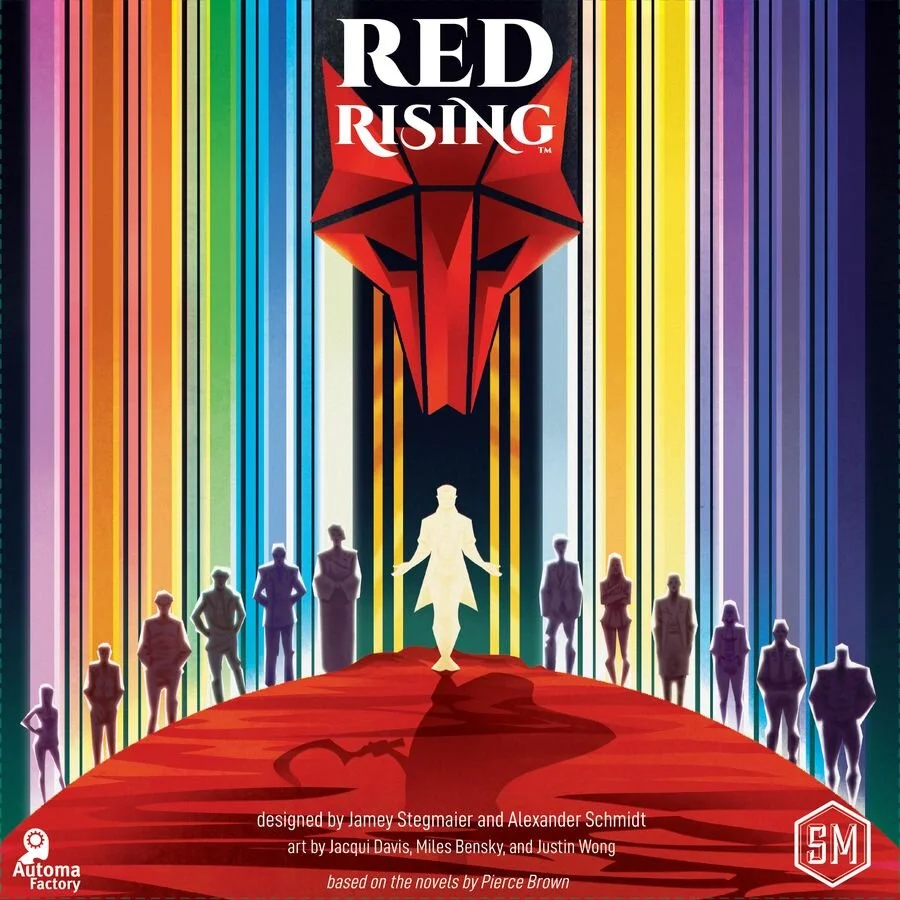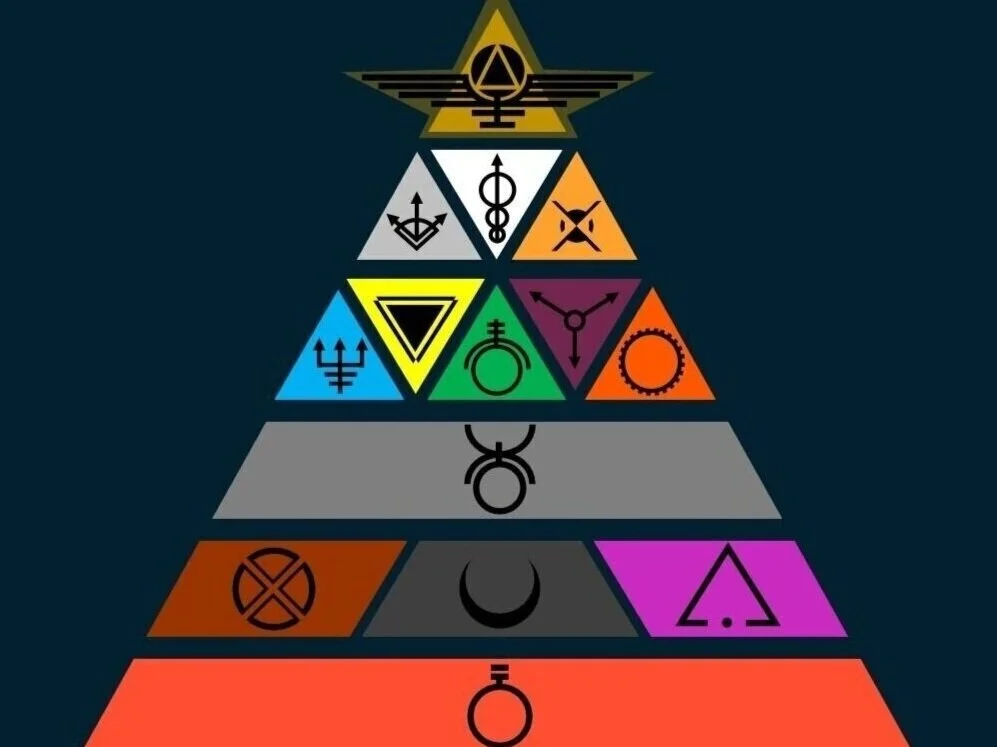Being able to spot great card combos is the key to victory when playing Red Rising. Some of these combos can offer you bonus points during end game scoring, other combos give you bonus actions while deploying. If you can work your house power into the equation then it’s even better.
When gold rules with iron reins - There are 21 gold cards and only 7 cards in all other color decks. In general gold cards have higher core value overall and could be worth between 30 -40 points on average, or more if the end game bonus condition is met. If you can't find any synergy in your opening hand it may be a good start to pick up a gold card from the board and build a strategy around it.
The mechanics, the soldiers, and the programmers - The ones that I personally feel are most useful out of all 13 colors, not courting gold, are the orange and gray cards. Their end game ability can help other cards meet the required bonus conditions. Most of them also have decent core values and easy to achieve end game bonus requirements. If it is a color or a name you need to achieve the bonus, then be on the hunt for an orange or gray card that can get you there.
The green cards might be helpful if you are scoring grays. 4 out of 7 green cards allow players to bring out more cards from the deck to the board when deployed, thus helping to maximize scoring potential of gray cards.
Some colors combo well with particular Houses:
House Jupiter, the Blues, and the fleet track - Each step on the fleet track could potentially be worth up to 4 - 4.3 VPs on average after getting past level 7, and House Jupiter can gain bonus fleet track advancement when they gain the Sovereign token. Many blue cards' deploy ability are bonus fleet track advancements, when comboed with Jupiter’s house power they would become unstoppable. After deploying these cards out, don’t hesitate to take them back into your hand if those blue cards are still on the board, so you can trigger the combo again at a later time. If those cards are either Invictus (blue), Pelus (blue), or Virga (blue), then keep those in your hand for their end game scoring bonuses.
House Apollo, the whites, and the Sovereign token - House Apollo always goes first and gets an extra turn to go last. This means, if they want the Sovereign token, it is theirs. While in possession the Sovereign token, certain cards such as Martyr (white), Justice (white), and Seer’s (white) abilities would be interesting to catch the opponents off guard. The Sovereign token is worth 10 points at the end of the game, which is arguable higher than the combined value of a single step on the fleet track, one influence token and one helium. If you manage to keep Bondilus (copper), Nero (gold), Octavia (gold), Lysender (gold), Romulus (gold) or The Jackal (gold) at the end of the game then the Sovereign token becomes even more valuable.
House Diana, the coppers, and the Institute - At the end of the game, the player with the most influence tokens at the institute would gain 4 points per token. House Diana can put one of these tokens at the institute when the Sovereign token is gained. Certain copper cards also let players add influence to the institute when deployed so when comboed with Diana’s house power they could earn and maintain the majority status in the institute easily. Politician (copper) and Timony (copper) have end game bonuses for having most influence at the institute. If you want to deploy these two cards to trigger the deploy bonus, my advice is to only do so after you have gained a big lead in the Institute. This way, the other players would have less incentive to take those cards during their turn and you can be pull those back after one round and keep it in your hand to score at the end.
House Mars, the silvers, and heliums - House Mars specializes in Helium. This resource is only 3 points each so it may not be a good long term investment. The return is not as good as investing long term in the Institute or Fleet track. However, they can be great if comboed with Sponsor (silver), Stock broker (silver), and Banker’s (silver) deploy abilities that allow you to spend helium in exchange for better benefits. If you end up with lots of Helium and Quicksilver (silver) comes in to play, be sure to snatch it before others do and secure your lead in having the most helium at the end of the game.
Banishing cards with House Ceres - For your first game, try to avoid House Ceres. When this house gains the Sovereign token, they can banish a card, which is good if the player knows what their opponents may need. They also begin with an extra card in hand so if they can make other players banish cards from their hands by playing cards like Aja (gold), Antonia (gold), Karnus (gold), Rogue (gold),Tactus (gold), and Hypnotist (yellow), this house could have a huge advantage. For scoring, House Ceres’ ability may combo well with Dr. Virany (yellow), Pathologist (yellow), Surgeon (yellow), and Ash Lord (gold) if the right cards are at the banished zone. Several black and yellow cards also let you banish cards from board directly.
By the way, If your opponents make you banish cards, be on the look out for cards that allow you to gain extra cards, either from the board, the banished or the deck. Several main characters from the novel such as Darrow (red), Mustang (gold), Victra (gold), and Octavia (gold) are notable examples and there are more than 20 cards in various colors that would also do this. My favorite ones are the three purple cards - Reporter, Holo Host and Vlogger. They that have the potential to go around the table, especially when there are only two players.
House Minerva - It may be a fun house for a player who don’t have a strategic preference and welcomes chaos and randomness while gaming. If you have a good strategy for this house, please share your insight in the comments.
Pinks, Browns and Reds - Most pink cards allow players to move cards to a different location, or gain a card of a particular color when deployed. It could be very helpful if you need to retrieve a specific card that's not easily accessible on the board. Similar to pink, most brown cards allow players to move other cards to a different location in addition to gaining some sort of benefit when deployed. Pink and brown cards are versatile and combo well with almost all houses and other colors.
Last but definitely not least are the Reds - the color I always root for. Deploying them mostly allow players to gain helium or make opponent lose helium. Generally, players are less likely to take red cards when they are on the board because their core values are low. If you have at least one red card with a good bonus (such as Eo or Harmony) in your opening hand and there are other reds in play, it would be fun to quietly collect and reunite these Red for sentimental reasons and as well as their collective end game bonuses.
Personally, I was looking forward to the release of Red Rising - the table top game, because I am a fan of the book series. The artists (Jacqui Davis, Miles Bensky, and Justin Wong) did a great job and it is really nice to finally “meet” these characters for the first time. If you have read the novel, you would definitely appreciate how you can trace bits and pieces of the story in some of the character’s abilities or end game bonuses. If you have not read Red Rising but love the table top version enough to be reading this article, then you would probably love it more if you go read the book!
-Jackie
(About the author - Jacqueline Chao is the executive producer and main content contributor at Show Me How to Win. Follow her board game journey on instagram @boardgamesetc )
Red Rising is designed by Jamey Stegmaier and Alexander Schmidt. It is based on the novels by Pierce Brown and published by Stonemaier Games in the US and our copy was provided by the publisher.
Image sources and credits:
https://stonemaiergames.com/games/red-rising/
https://www.reddit.com/r/redrising/comments/7um04z/pyramid_of_society_art/
https://www.facebook.com/SonsOfAres/
https://red-rising.fandom.com/wiki/Color (from Red Rising: Sons of Ares graphic novel)




